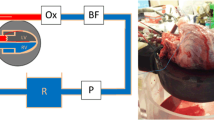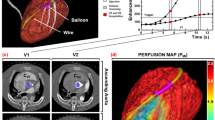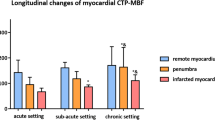Abstract
The purpose of the study is feasibility of dynamic CT perfusion imaging to detect and differentiate ischemic and infarcted myocardium in a large porcine model. 12 Country pigs completed either implantation of a 75 % luminal coronary stenosis in the left anterior descending coronary artery simulating ischemia or balloon-occlusion inducing infarction. Dynamic CT-perfusion imaging (100 kV, 300 mAs), fluorescent microspheres, and histopathology were performed in all models. CT based myocardial blood flow (MBFCT), blood volume (MBVCT) and transit constant (Ktrans), as well as microsphere’s based myocardial blood flow (MBFMic) were derived for each myocardial segment. According to histopathology or microsphere measurements, 20 myocardial segments were classified as infarcted and 23 were ischemic (12 and 14 %, respectively). Across all perfusion states, MBFCT strongly predicted MBFMic (β 0.88 ± 0.12, p < 0.0001). MBFCT, MBVCT, and Ktrans were significantly lower in ischemic/infarcted when compared to reference myocardium (all p < 0.01). Relative differences of all CT parameters between affected and non-affected myocardium were higher for infarcted when compared to ischemic segments under rest (48.4 vs. 22.6 % and 46.1 vs. 22.9 % for MBFCT, MBVCT, respectively). Under stress, MBFCT was significantly lower in infarcted than in ischemic myocardium (67.8 ± 26 vs. 88.2 ± 22 ml/100 ml/min, p = 0.002). In a large animal model, CT-derived parameters of myocardial perfusion may enable detection and differentiation of ischemic and infarcted myocardium.







Similar content being viewed by others
References
Blankstein R, Jerosch-Herold M (2010) Stress myocardial perfusion imaging by computed tomography a dynamic road is ahead. JACC Cardiovasc Imaging 3(8):821–823. doi:10.1016/j.jcmg.2010.06.008
Rocha-Filho JA, Blankstein R, Shturman LD, Bezerra HG, Okada DR, Rogers IS, Ghoshhajra B, Hoffmann U, Feuchtner G, Mamuya WS, Brady TJ, Cury RC (2010) Incremental value of adenosine-induced stress myocardial perfusion imaging with dual-source CT at cardiac CT angiography. Radiology 254(2):410–419. doi:10.1148/radiol.09091014
Cury RC, Nieman K, Shapiro MD, Butler J, Nomura CH, Ferencik M, Hoffmann U, Abbara S, Jassal DS, Yasuda T, Gold HK, Jang IK, Brady TJ (2008) Comprehensive assessment of myocardial perfusion defects, regional wall motion, and left ventricular function by using 64-section multidetector CT. Radiology 248(2):466–475. doi:10.1148/radiol.2482071478
Bamberg F, Becker A, Schwarz F, Marcus RP, Greif M, von Ziegler F, Blankstein R, Hoffmann U, Sommer WH, Hoffmann VS, Johnson TR, Becker HC, Wintersperger BJ, Reiser MF, Nikolaou K (2011) Detection of hemodynamically significant coronary artery stenosis: incremental diagnostic value of dynamic CT-based myocardial perfusion imaging. Radiology 260(3):689–698. doi:10.1148/radiol.11110638
So A, Hsieh J, Imai Y, Narayanan S, Kramer J, Procknow K, Dutta S, Leipsic J, Min JK, Labounty T, Lee TY (2012) Prospectively ECG-triggered rapid kV-switching dual-energy CT for quantitative imaging of myocardial perfusion. JACC Cardiovasc Imaging 5(8):829–836. doi:10.1016/j.jcmg.2011.12.026
George RT, Arbab-Zadeh A, Miller JM, Vavere AL, Bengel FM, Lardo AC, Lima JA (2012) Computed tomography myocardial perfusion imaging with 320-row detector computed tomography accurately detects myocardial ischemia in patients with obstructive coronary artery disease. Circ Cardiovasc Imaging 5(3):333–340. doi:10.1161/CIRCIMAGING.111.969303
Bastarrika G, Ramos-Duran L, Rosenblum MA, Kang DK, Rowe GW, Schoepf UJ (2010) Adenosine-stress dynamic myocardial CT perfusion imaging: initial clinical experience. Invest Radiol 45(6):306–313. doi:10.1097/RLI.0b013e3181dfa2f2
Ho KT, Chua KC, Klotz E, Panknin C (2010) Stress and rest dynamic myocardial perfusion imaging by evaluation of complete time-attenuation curves with dual-source CT. JACC Cardiovasc Imaging 3(8):811–820. doi:10.1016/j.jcmg.2010.05.009
Wang Y, Qin L, Shi X, Zeng Y, Jing H, Schoepf UJ, Jin Z (2012) Adenosine-stress dynamic myocardial perfusion imaging with second-generation dual-source CT: comparison with conventional catheter coronary angiography and SPECT nuclear myocardial perfusion imaging. AJR Am J Roentgenol 198(3):521–529. doi:10.2214/AJR.11.7830
Koenig M, Klotz E, Luka B, Venderink DJ, Spittler JF, Heuser L (1998) Perfusion CT of the brain: diagnostic approach for early detection of ischemic stroke. Radiology 209(1):85–93. doi:10.1148/radiology.209.1.9769817
Nabavi DG, Cenic A, Craen RA, Gelb AW, Bennett JD, Kozak R, Lee TY (1999) CT assessment of cerebral perfusion: experimental validation and initial clinical experience. Radiology 213(1):141–149. doi:10.1148/radiology.213.1.r99oc03141
Tomandl BF, Klotz E, Handschu R, Stemper B, Reinhardt F, Huk WJ, Eberhardt KE, Fateh-Moghadam S (2003) Comprehensive imaging of ischemic stroke with multisection CT. Radiographics Rev Publ Radiol Soc N Am 23(3):565–592. doi:10.1148/rg.233025036
Shaw LJ, Berman DS, Maron DJ, Mancini GB, Hayes SW, Hartigan PM, Weintraub WS, O’Rourke RA, Dada M, Spertus JA, Chaitman BR, Friedman J, Slomka P, Heller GV, Germano G, Gosselin G, Berger P, Kostuk WJ, Schwartz RG, Knudtson M, Veledar E, Bates ER, McCallister B, Teo KK, Boden WE, Investigators C (2008) Optimal medical therapy with or without percutaneous coronary intervention to reduce ischemic burden: results from the Clinical Outcomes Utilizing Revascularization and Aggressive Drug Evaluation (COURAGE) trial nuclear substudy. Circulation 117(10):1283–1291. doi:10.1161/CIRCULATIONAHA.107.743963
Tonino PA, De Bruyne B, Pijls NH, Siebert U, Ikeno F, van’ t Veer M, Klauss V, Manoharan G, Engstrom T, Oldroyd KG, Ver Lee PN, MacCarthy PA, Fearon WF, Investigators FS (2009) Fractional flow reserve versus angiography for guiding percutaneous coronary intervention. N Engl J Med 360(3):213–224. doi:10.1056/NEJMoa0807611
Bamberg F, Hinkel R, Schwarz F, Sandner TA, Baloch E, Marcus R, Becker A, Kupatt C, Wintersperger BJ, Johnson TR, Theisen D, Klotz E, Reiser MF, Nikolaou K (2012) Accuracy of dynamic computed tomography adenosine stress myocardial perfusion imaging in estimating myocardial blood flow at various degrees of coronary artery stenosis using a porcine animal model. Invest Radiol 47(1):71–77. doi:10.1097/RLI.0b013e31823fd42b
Boekstegers P, Raake P, Al Ghobainy R, Horstkotte J, Hinkel R, Sandner T, Wichels R, Meisner F, Thein E, March K, Boehm D, Reichenspurner H (2002) Stent-based approach for ventricle-to-coronary artery bypass. Circulation 106(8):1000–1006
Mahnken AH, Bruners P, Katoh M, Wildberger JE, Gunther RW, Buecker A (2006) Dynamic multi-section CT imaging in acute myocardial infarction: preliminary animal experience. Eur Radiol 16(3):746–752. doi:10.1007/s00330-005-0057-5
Miles KA (2002) Functional computed tomography in oncology. Eur J Cancer 38(16):2079–2084
Patlak CS, Blasberg RG, Fenstermacher JD (1983) Graphical evaluation of blood-to-brain transfer constants from multiple-time uptake data. J Cereb Blood Flow Metab 3(1):1–7. doi:10.1038/jcbfm.1983.1
Cerqueira MD, Weissman NJ, Dilsizian V, Jacobs AK, Kaul S, Laskey WK, Pennell DJ, Rumberger JA, Ryan T, Verani MS (2002) Standardized myocardial segmentation and nomenclature for tomographic imaging of the heart: a statement for healthcare professionals from the Cardiac Imaging Committee of the Council on Clinical Cardiology of the American Heart Association. Circulation 105(4):539–542
Cerqueira MD, Weissman NJ, Dilsizian V, Jacobs AK, Kaul S, Laskey WK, Pennell DJ, Rumberger JA, Ryan T, Verani MS, Imaging AHAWGoMSaRfC (2002) Standardized myocardial segmentation and nomenclature for tomographic imaging of the heart. A statement for healthcare professionals from the Cardiac Imaging Committee of the Council on Clinical Cardiology of the American Heart Association. Int J Cardiovasc Imaging 18(1):539–542
Glenny RW, Bernard S, Brinkley M (1993) Validation of fluorescent-labeled microspheres for measurement of regional organ perfusion. J Appl Physiol 74(5):2585–2597
Thein E, Raab S, Harris AG, Messmer K (2000) Automation of the use of fluorescent microspheres for the determination of blood flow. Comput Methods Programs Biomed 61(1):11–21
George RT, Silva C, Cordeiro MA, DiPaula A, Thompson DR, McCarthy WF, Ichihara T, Lima JA, Lardo AC (2006) Multidetector computed tomography myocardial perfusion imaging during adenosine stress. J Am Coll Cardiol 48(1):153–160. doi:10.1016/j.jacc.2006.04.014
Rossi A, Uitterdijk A, Dijkshoorn M, Klotz E, Dharampal A, van Straten M, van der Giessen WJ, Mollet N, van Geuns RJ, Krestin GP, Duncker DJ, de Feyter PJ, Merkus D (2012) Quantification of myocardial blood flow by adenosine-stress CT perfusion imaging in pigs during various degrees of stenosis correlates well with coronary artery blood flow and fractional flow reserve. Eur Heart J Cardiovasc Imaging. doi:10.1093/ehjci/jes150
Finn JP, Nael K, Deshpande V, Ratib O, Laub G (2006) Cardiac MR imaging: state of the technology. Radiology 241(2):338–354. doi:10.1148/radiol.2412041866
Mahnken AH, Klotz E, Pietsch H, Schmidt B, Allmendinger T, Haberland U, Kalender WA, Flohr T (2010) Quantitative whole heart stress perfusion CT imaging as noninvasive assessment of hemodynamics in coronary artery stenosis: preliminary animal experience. Invest Radiol 45(6):298–305. doi:10.1097/RLI.0b013e3181dfa3cf
Hori M, Kitakaze M (1991) Adenosine, the heart, and coronary circulation. Hypertension 18(5):565–574
Acknowledgments
This study supported by an unrestricted grant by Bayer Healthcare, Berlin, Germany and by the DZHK (German Centre for Cardiovascular Research) and by the BMBF (German Ministry of Education and Research).
Conflict of interest
None.
Author information
Authors and Affiliations
Corresponding author
Rights and permissions
About this article
Cite this article
Bamberg, F., Hinkel, R., Marcus, R.P. et al. Feasibility of dynamic CT-based adenosine stress myocardial perfusion imaging to detect and differentiate ischemic and infarcted myocardium in an large experimental porcine animal model. Int J Cardiovasc Imaging 30, 803–812 (2014). https://doi.org/10.1007/s10554-014-0390-3
Received:
Accepted:
Published:
Issue Date:
DOI: https://doi.org/10.1007/s10554-014-0390-3




